Gujarat Board GSEB Textbook Solutions Class 8 Maths Chapter 6 Square and Square Roots Ex 6.4 Textbook Questions and Answers.
Gujarat Board Textbook Solutions Class 8 Maths Chapter 6 Square and Square Roots Ex 6.4
Question 1.
Find the square root of each of the following numbers by Division method?
- 2304
- 4489
- 3481
- 529
- 3249
- 1369
- 5776
- 7921
- 576
- 1024
- 3136
- 900
Solution:
1. We have:
∴ \(\sqrt{2304}\) = 48
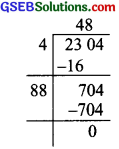
2. We have:
∴ \(\sqrt{4489}\) = 67
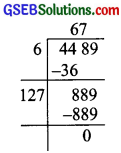
3. We have:
∴ \(\sqrt{3481}\) = 59
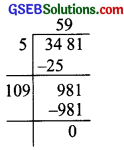
4. We have:
∴ \(\sqrt{529}\) = 23
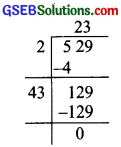
5. We have:
∴ \(\sqrt{3249}\) = 57

6. We have:
∴ \(\sqrt{1369}\) = 37
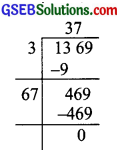
7. We have:
∴ \(\sqrt{5776}\) = 76

8. We have:
∴ \(\sqrt{7921}\) = 89
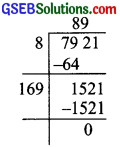
9. We have:
∴ \(\sqrt{576}\) = 24
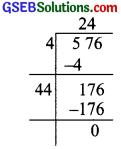
10. We have:
∴ \(\sqrt{1024}\) = 32
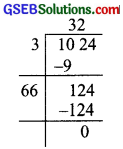
11. We have:
∴ \(\sqrt{3136}\) = 56

12. We have:
∴ \(\sqrt{900}\) = 30
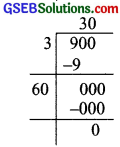
![]()
Question 2.
Find the number of digits in the square root of each of the following numbers (without any calculation).
- 64
- 144
- 4489
- 27225
- 390625
Solution:
If ‘V’ stands for number of digits in the given number, then
1. For 64, n = 2 [even number]
∴ Number of digit is its square root
= \(\frac{n}{2}\) = \(\frac{2}{2}\) = 1
2. For 144, n = 3 [odd number]
∴ Number of digits in its square root
= \(\frac{n+1}{2}\) = \(\frac{3+1}{2}\) = \(\frac{4}{2}\) = 2
3. For 4489, n = 4 [even number]
Number of digits in its square root
= \(\frac{n}{2}\) = \(\frac{4}{2}\) = 2
4. For 27225, n = 5 [odd number]
∴ Number of digits in its square root
= \(\frac{n+1}{2}\) = \(\frac{5+1}{2}\)
= \(\frac{6}{2}\) = 3
5. For 390625, n = 6 [even number]
∴ Number of digits in its square root
= \(\frac{n}{2}\) = \(\frac{6}{2}\) = 3
![]()
Question 3.
Find the square root of the following decimal numbers?
- 2.56
- 7.29
- 51.84
- 42.25
- 31.36
Solution:
1. \(\sqrt{2.56}\)
Here, number of decimal places, are already even.
∴ We mark off’the periods and find the square root.
∴ \(\sqrt{2.56}\) = 1.6
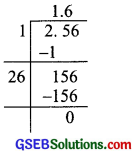
2. \(\sqrt{7.29}\)
Here, number of decimal places are already even. Therefore, we mark off the periods and find the square root.
∴ \(\sqrt{7.29}\) = 2.7
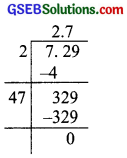
3. \(\sqrt{51.84}\)
Here, the decimal places are already even.
∴ We mark off the periods and find the square root:
∴ \(\sqrt{51.84}\) = 7.2
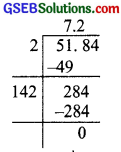
4. \(\sqrt{42.25}\)
Here, the decimal places are already even.
∴ We mark off periods and find the square root:
∴ \(\sqrt{42.25}\) = 6.5
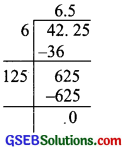
5. \(\sqrt{31.36}\)
Here, the decimal places are already even.
∴ We mark off the periods and find the square root:
∴ \(\sqrt{31.36}\) = 5.6
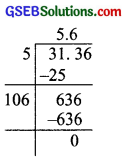
![]()
Question 4.
Find the least number which must be subtracted from each of the following numbers so as to get a perfect square. Also find the square root of the perfect square so obtained?
- 402
- 1989
- 3250
- 825
- 4000
Solution:
1. Since, we get a remainder 2
∴ The required least number to be subtracted from 402 is 2.
∴ 402 – 2 = 400, and \(\sqrt{400}\) = 20

2. Since, we get a remainder of 53
∴ The least number to be subtracted from the given number = 53
1989 – 53 = 1936,
and \(\sqrt{1936}\) = 44
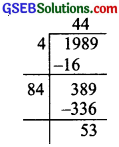
3. Since, we get a remainder 1
∴ The smallest number to 53250 be subtracted from the given number = 1
Now, 3250 – 1 = 3249,
and \(\sqrt{3249}\) = 57
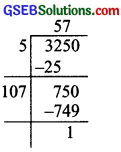
4. Since, we get a remainder 41
∴ The required smallest number to be subtracted from the given number = 41
Now, 825 – 41 = 784,
and \(\sqrt{784}\) = 28
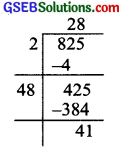
5. Since, we get a remainder 31
∴ The required smallest number to be subtracted from the given number = 31
Now, 4000 – 31 = 3969,
and \(\sqrt{3969}\) = 63
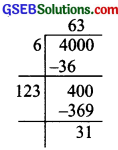
![]()
Question 5.
Find the least number which must be added to each of the following numbers so as to get a perfect square. Also find the square root of the perfect square so obtained?
- 525
- 1750
- 252
- 1825
- 6412
Solution:
1. Since, we get a remainder 41.
i.e; 525 > 222
and next square number is 23.
The required number to be added
= 232 – 525
= 529 – 525 = 4
Now, 524 + 4 = 529, and \(\sqrt{529}\) = 23.
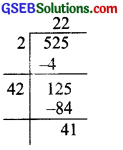
2. Since, we get a remainder 69.
i.e., 1750 > (41)2
and next square number is 422.
∴ The required number to be added = 422 – 1750
= 1764 – 1750 = 14
Now, 1750 + 14 = 1764, and \(\sqrt{1764}\)
and \(\sqrt{1764}\) = 42
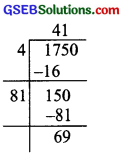
3. Since, we get a remainder 27.
Since, 252 > (15)2 and next
square number = 16
∴ The required number to be added = 162 – 252
= 256 – 252 = 4
Now, 252 + 4 = 256, and \(\sqrt{256}\) = 16
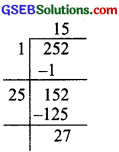
4. Since, we get a remainder, 61.
∴ 1825 > (42)2
∵ Next square number = 43
∴ The required number to be added = (43)2 – 1825
= 1849 – 1825 = 24
Now, 1825 + 24 = 1849
and \(\sqrt{1849}\) = 43

5. Since, we get a remainder 12.
∴ 6412 > (80)2
∵ Next square number = 81
∴ Required number to be added = (81)2 – 6412
= 6561 – 6412 = 149
Now, 6412 + 149 = 6561 and \(\sqrt{6561}\) = 81
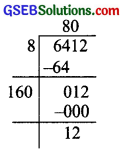
![]()
Question 6.
Find the length of the side of a square whose area is 441 m2?
Solution:
Let the side of the square = x metre
∴ Area = side × side
= x × x = x2 metre2
∴ x2 = 441 ⇒ \(\sqrt{x^{2}}=\sqrt{441}\)
x = \(\sqrt{441}\) = 21
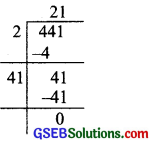
Thus, the required side is 21m.
Question 7.
In a right triangle ABC, ∠B = 90°.
(a) If AB = 6 cm, BC = 8 cm. find AC.
(b) If AC = 13 cm, BC = 5 cm, find AB.
Solution:
I. In a right triangle, the the hypotenuse.
II. (Hypotenuse)2 = [Sum of the squares of other two sides]
(a) ∵ ∠B = 90°
∴ Hypotenuse = AC
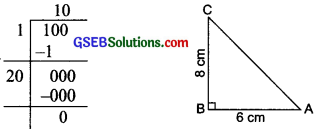
∴ AC2 = AB2 + BC2 = 82 + 62 = 64 = 100
\(\sqrt{A C^{2}}\) = \(\sqrt{100}\)
AC = 10
Thus, AC = 10 cm
(b) Here ∠B = 90°
∴ Hypotenuse = AC
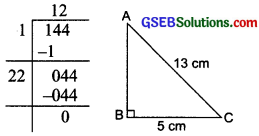
∵ AC2 = AB2 + BC2 or 132 = AB2 + 52
or AB2 = 132 – 52 = 169 – 25 = 144
Now \(\sqrt{A B^{2}}\) = \(\sqrt{144}\) or AB = 12
Thus, AB = 12 cm
Question 8.
A gardener has 1000 plants. He wants to plant these in such a way that the number of rows and the number of columns remain same. Find the minimum number of plants he needs more for this?
Solution:
Since, the number of plants in a row and the number of columns are the same.
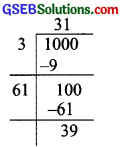
∴ Their product must be a square number.
∵ The gardener has 1000 plants.
∴ 1000 is not a perfect square, and (31)2 < 1000
(∵ There is a remainder of 39).
Obviously the next square number = 32
∴ Number of plants required to be added
= (32)2 – 1000
= 1024 – 1000 = 24
![]()
Question 9.
There are 500 children in a school. For a P.T. drill they have to stand in such a manner that the number of rows is equal to number of columns. How many children would be left out in this arrangement?
Solution:
Since, the number of rows and the number of columns are same.
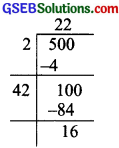
∴ Total number (i.e. their product) must be a square number, we have
Since, we get a remainder of 16
∴ 500 > (22)2 or 500 – 16 = (22)2
Thus, the required number of children to be left out = 16.